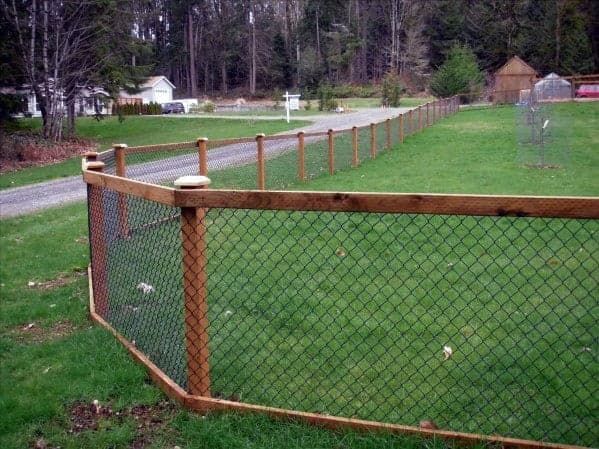Learn How To Keep A Dog In A Fence. A good enclosed backyard where your dog can wander, discover interesting objects, and take a nap in the shade is a need for many dog owners. Except when your dog decides the grass is greener somewhere else and turns into a brilliant escape artist, it’s perfect. From the kitchen window, you can see them one moment, and the next, they are gone.
Now that technology has advanced, there are even more ways to monitor your dog. A GPS-enabled device, such as the brand-new Fi Smart Dog Collar, is an excellent tool for ongoing tracking of your dog and alerting you when they escape. Furthermore, with features like a live map on your phone, collars like this make finding your dog much simpler in the event of a successful escape.
It is upsetting to feel like you can’t trust your dog, even in your backyard, and worry about their safety. Don’t give up; there are a few quite easy things you can do to prevent your dog from fleeing the yard or to track them down if they do.
In the end, a sturdy fence keeps your dog in your yard and other dogs (and potential threats) out. Unfortunately, many dogs view fences as obstacles they must overcome. They want to pierce, climb, or dig beneath it. Let’s look at some strategies to keep your dog inside your fence, as the purpose of a fence is not to turn it into a puzzle for your dog to solve

Remove escaping aids
It’s incredible what dogs can use to their advantage to get out of the yard. A trash can kept next to the fence is used as a step stool and climbing aid. The same phenomenon happens when firewood is stacked next to a fence; climbing up on the firewood and then hopping or climbing the barrier is simple. Another way out is a tree with a low branch dangling over the fence. Remove all those climbing aids after taking a stroll around your yard and viewing everything from your dog’s perspective.
Limit Your Dog's Viewing
Dogs frequently attempt to leave the yard because they can see the excitement that awaits them beyond the fence. He is likelier to attempt to flee if he can see the dogs in the yard next door, kids heading home from school, other dogs walking past the house, or squirrels playing out front. There are numerous ways to restrict your dog’s vision through the fence, depending on the sort of fencing you have. Rolls of reed fencing are available and reasonably priced. You can attach this to the inside of your current fence to reduce visibility. Although it won’t completely obstruct visibility, weaving plastic slats through a chain link fence will assist. Many dog owners cultivate climbing plants or fast-growing vines on their fences. This is a lovely alternative; however, keep the dog away until the plants are established.
Prevent Fence Tunnels
Dogs who try to escape by digging under a fence might be tenacious. Filling in every hole these dogs dig typically won’t stop them, which can be annoying as it can feel like an endless effort. Therefore, a longer-lasting fix is preferable. The best course of action is to build an L-footer along the fence’s base. Alongside your fence, unfold a roll of thick hardware cloth or garden fencing (wire fencing with squares of wire). The fencing should be bent so that a foot of it may be joined to your fence, and the remaining portion will rest flat at the base of the fence enclosing your yard. The term “L-fence” refers to the L shape that the fencing takes once it is formed. The L’s base can be secured to the ground with stakes, covered with dirt, gravel, or rocks, or left open for grass to grow. If you let the grass grow, keep it in mind and cut it with other, safer tools rather than mowing over it.
Prevent Fence Jumpers
Create an L-footer and flip it upside down so it’s at the top of your fence if your dog enjoys jumping. When your dog looks up, the fencing will be above him when you make an L-shape and tie the short side to the top of your fence with the rest of the garden or hardware fencing. Thoughtfulness will be required to anchor this barrier. To build supports that are fastened to the top of your fence and will hold up the folded-over garden fence, you can use some lumber, big-angle irons, or even metal shelf supports. Examine your fence and exercise your creativity.

Climbers Stop Coyote Rollers
Coyote rollers are made to slow down or prevent coyotes from entering your yard and work just as well to prevent dogs from leaving. Coyote roller setups are available commercially, but if you’re handy, you can make your own. Essentially, these are made out of a metal cable installed at the top of the fence. The plastic pipe’s core is where the cable is threaded (usually a three to four-inch diameter pipe). The cable is set high enough above the fence to prevent a dog or coyote from slipping between the top and the cable while allowing the pipe to move freely on the wire. The pipe rolls as the dog (or coyote) try to climb the fence and grab hold of it, causing the animal to fall back to the ground.
Dual Gates Prevent Hurried Entry
A double gate can assist in stopping your dog from running through the fence if they are gate dashers or if people frequently enter and exit the gate. An airlock-like double gate works similarly; you pass through one, close it behind you, and then open the other. Always shutting one gate before opening the next is the secret to success. A double gate can be made with just a few fencing panels and a new gate. Depending on the available space and your personal preferences, you can construct it either within or outside the current fence.
Lock up the gates.
My yard gate is constantly secured with a padlock. My dogs are great at waiting for permission to go outside and don’t dash the gate, but what if I’m not home? What if I’m occupied? Additionally, I don’t want a delivery person, a neighbour, or any kids from the neighbourhood to enter my gate. So the gate is always locked with a padlock. However, the lock’s keys must be simple to get to in an emergency. It would be best to decide who requires keys and where they should be kept.
Why Your Dog Is Running Away, and How to Stop It
Your dog can opt to stray if they feel lonely outside. Despite the lovely space, they might prefer your companionship or be yearning for a friend. A territorial dog may see anything beyond its border that it perceives as a threat to the house and must go out and repel it.
On the other side, they might have discovered “treasure” in the form of a companion to play with, food, a tempting stream of water, or a sizable field to play in. Of course, some hunters hunt primarily for prey. They won’t be prevented from chasing a squirrel or rabbit that just ran through the yard by a simple fence. They might be a young child or a puppy with excessive energy who needs more ways to burn it off.
Dogs can escape in a variety of ways. Some people are jumpers; they take off running from the ground and jump. Some people climb up the fence using whatever is there before jumping over. Other dogs are tireless diggers who tunnel their way to freedom. Then there are the fence climbers, who can gnaw a hole big enough for them to squeeze through. The cerebral kind might discover how to open a gate truly. When the gate is opened, some dogs charge it and bolt outside before you can catch them. Determined dogs will combine these methods.
Even if you have a lovely fenced-in yard, you should still walk your dog daily, even though it might seem counterproductive. Your dog may be able to burn off some of their excess energy and prevent boredom while playing in the yard, thanks to the excellent physical and mental activity that comes with a stroll.
